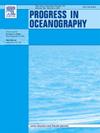加利福尼亚洋流上升流系统中的季节性溶解氧气体交换
IF 3.6
3区 地球科学
Q1 OCEANOGRAPHY
引用次数: 0
摘要
东部边界流系统以季节性上涌而闻名,它将水从混合层下面带到地表。该过程通过将低溶解氧水靠近地表来脱氧水柱,并通过从深水注入营养物质来提高初级生产力来脱氧水柱。本文利用5年的溶解氧、温度和盐度观测数据集,从海岸到近海约400公里,研究了上升流区海气氧交换的季节演变。这些数据是作为加州水下滑翔机网络(CUGN)的一部分收集的,该网络全年监测加利福尼亚州蒙特利湾附近66.7样线、加利福尼亚州概念点附近80.0样线和加利福尼亚州达纳点附近90.0样线。在春季和夏季,狭窄的海岸氧欠饱和带驱动海洋对溶解氧的吸收,而在冬季,由于更广泛但不那么强烈的氧欠饱和,溶解氧的吸收占主导地位。在暖变和初级生产力的驱动下,在春季和夏季,在近岸吸收带的近海发生氧气放空,使得从海岸向海的累计净氧气交换在距离海岸100公里左右达到零。在上升流季节,由于浅滩等平线的作用,观察到上层海洋的通风。放气和吸收之间的平衡是这样的,加州中南部洋流系统是一个氧气净放气的区域,从海岸到66.7、80.0和90.0线分别为400公里、365公里和530公里的区域。引起吸收和放气的竞争因素以及区域的向海范围决定了上升流区是氧气的净源还是净汇。加利福尼亚沿海的海洋学是这样的:在近岸50公里处,水的季节性垂直和离岸运动降低了水中的溶解氧浓度。科学家们通过自主水下航行器观察海洋中溶解氧的变化,从而观察季节变化。发现溶解氧在上升流期间进入沿海地区的海洋,而它从更远的海洋中释放出来。一些进入海洋表层的溶解氧进入了更深的水域。从海洋表面释放的溶解氧气体的量补偿了发生的吸氧量。从海岸到距离海岸约400公里的区域向大气中释放了氧气。本文章由计算机程序翻译,如有差异,请以英文原文为准。
Seasonal dissolved oxygen gas exchange in the California Current Upwelling System
Eastern boundary current systems are known for seasonal upwelling that brings water from below the mixed layer to the surface. The process deoxygenates the water column by bringing lower-dissolved oxygen water closer to the surface and oxygenates the water column by driving primary productivity due to the injection of nutrients from deep waters. Here, an observational dataset of 5 years of dissolved oxygen, temperature, and salinity measured to 500 m and from the coast to around 400 km offshore is used to study the seasonal evolution of air-sea exchange of oxygen in an upwelling region. The data were collected as part of the California Underwater Glider Network (CUGN) which monitors transect line 66.7 off of Monterey Bay, CA, transect line 80.0 off of Point Conception, CA, and transect line 90.0 off of Dana Point, CA year-round. A narrow band of coastal oxygen undersaturation drives dissolved oxygen uptake by the ocean in spring and summer, while in winter dissolved oxygen uptake predominates due to more widespread but less intense oxygen undersaturation. Oxygen outgassing occurs offshore of the nearshore uptake band in spring and summer, driven by warming and primary productivity, such that the cumulative net oxygen gas exchange integrated seaward from shore reaches zero once around one hundred kilometers from the coast. Ventilation of the upper ocean is observed as a result of shoaling isopycnals in the upwelling season. The balance between outgassing and uptake is such that the central and southern California Current System is a region of net outgassing of oxygen for a region from the coast to 400 km, 365 km, and 530 km for lines 66.7, 80.0, and 90.0 respectively. Competing factors causing uptake and outgassing and the seaward extent of the domain determine whether an upwelling zone is a net source or sink of oxygen gas.
Plain Language Summary
The oceanography of coastal California is such that a seasonal vertical and offshore movement of water in the nearshore 50 km reduces the dissolved oxygen concentration of the water. The dissolved oxygen changes in the ocean were observed with autonomous underwater vehicles that allowed scientists to observe seasonal changes. Dissolved oxygen gas was found to enter the ocean in the coastal region during times of upwelling while it was released from the ocean further offshore. Some dissolved oxygen that entered the ocean surface layer found its way to deeper waters. The amount of dissolved oxygen gas released from the surface ocean compensated for the amount of oxygen uptake that occurred. The region from the coast to around 400 km from shore released oxygen gas to the atmosphere overall.
求助全文
通过发布文献求助,成功后即可免费获取论文全文。
去求助
来源期刊

Progress in Oceanography
地学-海洋学
CiteScore
7.20
自引率
4.90%
发文量
138
审稿时长
3 months
期刊介绍:
Progress in Oceanography publishes the longer, more comprehensive papers that most oceanographers feel are necessary, on occasion, to do justice to their work. Contributions are generally either a review of an aspect of oceanography or a treatise on an expanding oceanographic subject. The articles cover the entire spectrum of disciplines within the science of oceanography. Occasionally volumes are devoted to collections of papers and conference proceedings of exceptional interest. Essential reading for all oceanographers.
 求助内容:
求助内容: 应助结果提醒方式:
应助结果提醒方式:


